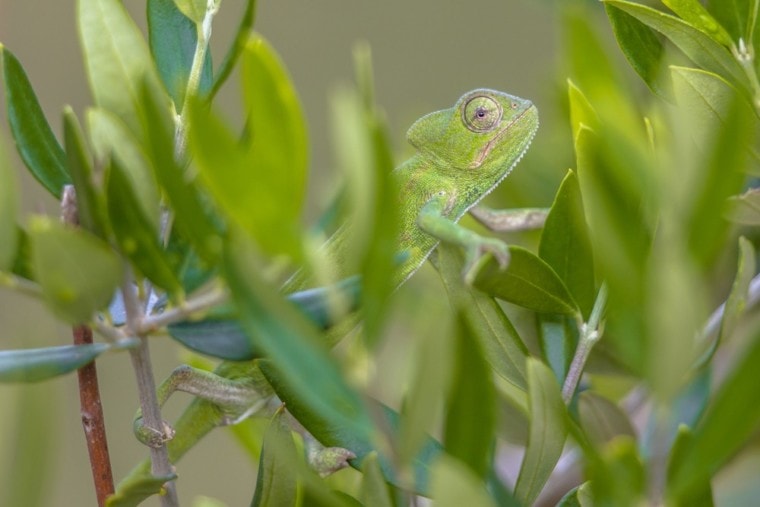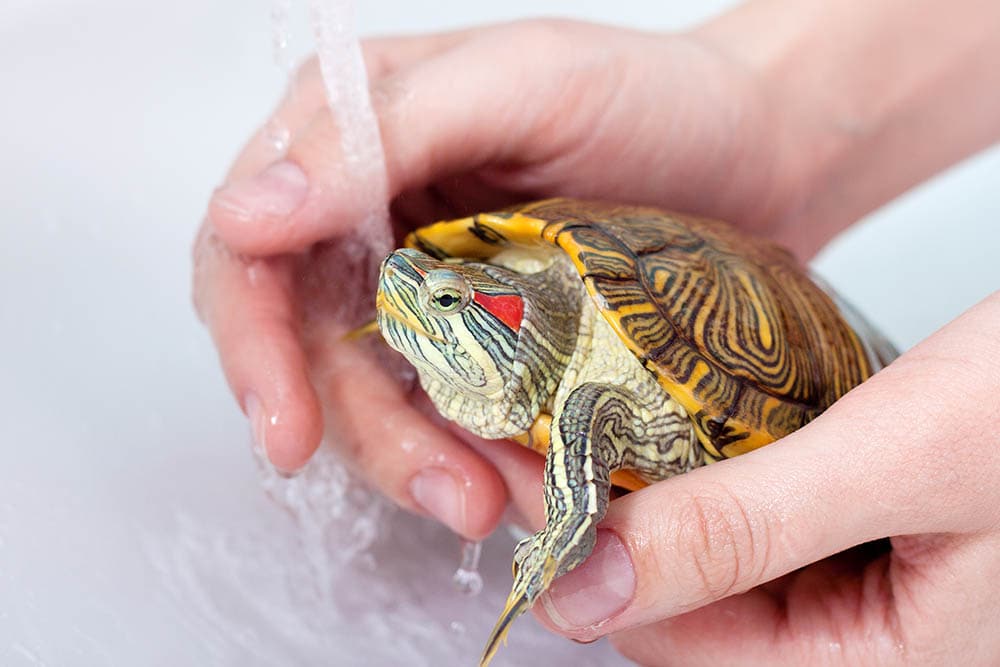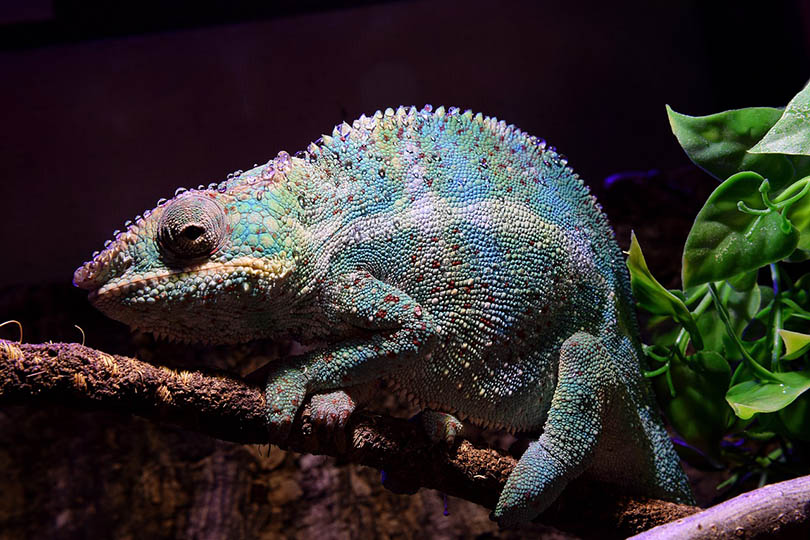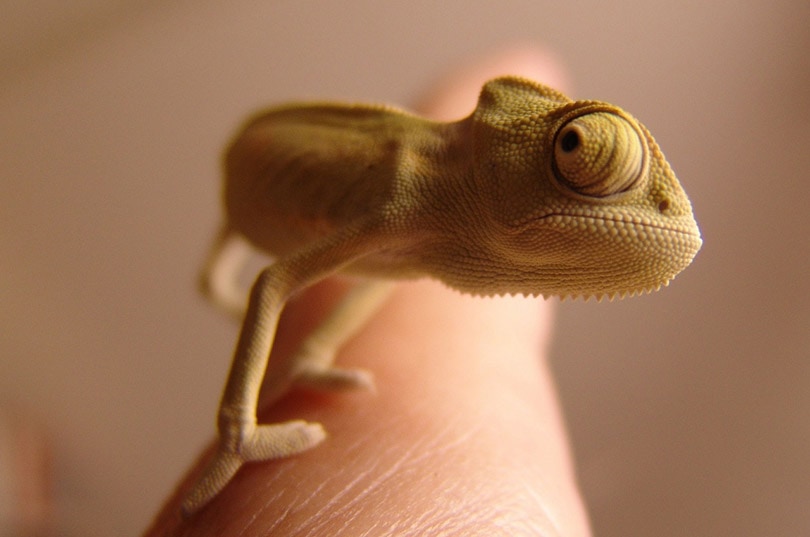
| Length: | Up to 8 inches |
| Weight: | Approximately 1 ounce |
| Lifespan: | 5 years |
| Colors: | Green with spots, colors change with mood to duller or brighter shades |
| Temperament: | Docile, Very territorial, Not playful, Easily stressed |
| Best Suited For: | Experienced reptile owners |
Senegal chameleons are a very beautiful and exotic creature. Their color-changing capabilities are just so magical to watch. But raising one comes at a cost.
They require the utmost attention in every single aspect of their lives. Raising a chameleon is like having a full-time job. Senegal chameleons require lots of special habitat equipment, live food (insects), and precision when it comes to their environment.
But if you’re able to provide for these creatures, these are a welcome addition to any reptile lover’s home.
Senegal Chameleons – Before You Buy…

As with any chameleon, you want to preferably buy a captive-bred lizard. However, that can actually be pretty tough to do with Senegal chameleons. They’re actually so much more easily caught in the wild than bred in captivity. And collection, transport, and change in environment can be very hard and stressful for these little guys.
When shopping for a Senegal chameleon, you should first try to find out whether or not it was captive-bred. Wild-caught chameleons aren’t nearly as hearty as captive-bred, and they may have illnesses or disorders when you buy them. You also don’t know exactly what they’ve been eating out in the wild. This means that they will more than likely have parasites or harmful gut bacteria within them. If you do pick up a wild-caught chameleon, you’ll need to take it to the vet for fecal tests on a very regular basis to ensure your lizard’s gut health.
Also, you’ll need to beware if you get your hands on a breeding pair. Female Senegal chameleons can lay up to 70 eggs per year! You’ll soon be overrun with chameleons at that rate. And many of them may not survive due to stress alone.
What’s the Price of Senegal Chameleons??
The actual base cost of a Senegal chameleon is around $35. Now, that gets you the lizard. But we’d be lying if we didn’t tell you that owning a chameleon can be very expensive. It’s everything else that goes with properly raising a chameleon that makes them so impactful on your wallet.
Chameleons require very specific conditions to live and remain healthy. This includes hydration and humidity, temperature, and even UV light! In order to meet these conditions, you’ll have to purchase a combination of heat lamps, UV lamps, misters, and other monitoring instruments. And you’ll have to keep live food handy every day.

3 Little-Known Facts About Senegal Chameleons
1. Unmated Females Will Lay Infertile Eggs
If you purchase a single female chameleon, you may be surprised to see her laying eggs even without mating. This is actually quite common. The eggs will be infertile and won’t hatch. So if you have a female, be sure to create a place for her in the habitat. Alternatively, lower her temperature just a bit and give her less food to minimize this from happening.
2. Senegal Chameleons Are Native to West Africa
Senegal chameleons get their name from where they’re most commonly found, Senegal. However, their range isn’t just limited to Senegal. It extends all the way into Mali, Nigeria, and Cameroon.
3. A Senegal Chameleon’s Tongue Can be Twice Its Body Length
A Senegal chameleon’s tongue is its primary weapon when catching its prey. It lays in wait compressed like an accordion until it locates its unsuspecting victim. Then it lashes out with a spring-loaded power to snag onto its target. Its tongue secretes an almost glue-like substance to ensure what’s hit makes it back to its waiting jaws.
Temperament & Intelligence of the Senegal Chameleon
Look, but don’t touch. This is exactly how you should treat your Senegal Chameleon. Once your chameleon has settled into its habitat, you should have as little direct interaction with it as possible.
Instead, you can tell how your chameleon is feeling based on their color change. When your chameleon is feeling glum, you’ll notice that their color isn’t as bright and vibrant. And if they’re truly upset, they’ll turn shades of brown and black. But when you see them bright and colorful, you know that they’re doing ok.
Are These Chameleons Good for Families? 👪
If your family has experience raising reptiles, a Senegal chameleon could be a wonderful addition to your home — provided you have the means to properly care for one. However, if you have no experience with reptiles, this is not the pet for you.
Does This Breed Get Along with Other Pets?
Absolutely not. Chameleons are highly territorial and extremely solitary creatures, and the Senegal chameleon is no exception. They will become very stressed if exposed to others including other pets, people (including you), or other chameleons. As a matter of fact, simple reflections of themselves have been known to induce stress-related illnesses.
Things to Know When Owning a Senegal Chameleon:
You probably understand by now that caring for a chameleon is exceptionally difficult. There’s a lot of different factors you need to fully understand before undertaking the task of raising one at home.
Food & Diet Requirements 🐛
Senegal chameleons live off of a strictly live insect-based diet. This means you’re going to need to invest in an insect habitat to keep up with dietary requirements — unless you enjoy going to the pet shop or bait store every single day.
It’s also worth mentioning that these insects should be gut-loaded as well. This means that the insects should be fed special food that when eaten, adds more nutrition to your chameleon’s diet. There’s also special calcium dust that you can put on your insects to help prevent bone disorders in your lizard.
When feeding your chameleon, it’s important not to put too many bugs in at one time. Your lizard will not overfeed, which means that the leftovers will be left around the cage. Dead insects will start to decompose, making your chameleon more susceptible to illness. Living insects can also band together and attack your chameleon. Either way, it’s not good.
Exercise
Your Senegal chameleon will not be the most active creature you’ve ever raised. More than likely it will be one of the more docile ones. But that doesn’t mean they don’t want their exercise.
When building your chameleon’s habitat, you’ll want to make sure that there’s plenty of room for them to move around and lots of tree limbs that they can climb. We recommend that you actually build your habitat more vertically than horizontal.
Lighting and Heating🌡️
Your Senegal chameleon’s body is attuned to a very specific environment. And if you’re going to raise a healthy lizard, you’re going to need to do your best to replicate those conditions. Your enclosure should have strategically placed heat lamps to allow for three different temperature zones:
[/su_box]
You are also going to need UV lamps to help your chameleon stay healthy. These lights are used to help regulate their metabolism, appetite, and synthesize vitamin D. Vitamin D is exceptionally important for chameleons as it helps to strengthen their bones and joints.
If at all possible, you should take time to expose your chameleon to direct sunlight for several hours every day. However, this is hardly possible. So, we recommend getting UV lights with timers that activate on a 12-hour-on/12-hour-off cycle.
Hydration💧
Chameleons are native to extremely humid climates. And without that same humidity and level of hydration within your home, they aren’t going to last long. But it’s not as simple as just sticking a bowl of water into their enclosure.
They “drink” by licking dew and droplets of water off leaves, so you’ll have to mist them several times a day. This can be accomplished through manual misting (i.e., using a spray bottle) or through automatic means. A drip system or an automatic misting system is a sound investment for ensuring that the humidity in your chameleon’s enclosure stays high.
Health and Conditions 🏥
Well-cared-for Senegal chameleons can be pretty hearty creatures. However, you may be off to a rocky start even when you first get one. Senegal chameleons are more often than not wild-caught. The shipping and transport process alone can wreak havoc on their delicate constitutions. Not only that, but their wild diet makes them more prone to parasitic infestation.
Your chameleon may already have some form of stress-related illness when you take them home. The best way to nurse them back to health is to ensure that they have a proper environment and to give them their space. Seriously, they do not want to be handled. That may just complicate matters even more.
One of the illnesses brought on by the stress of shipping is known as dystocia. This happens when female egg carriers have depressed calcium levels or are too stressed and dehydrated to expel the eggs they are carrying. Without veterinary intervention, it’s a death note for them.
Another major issue your chameleon may encounter is dehydration. While it is common for your new lizard to be dehydrated upon receipt, dehydration can occur in long-term captives as well. That’s why it’s so critical to put an automatic drip or misting system in their enclosure and keep their humidity up.
- Here’s an interesting thought: Do Chameleons Have an Odor as a Pet?
Male vs Female
Both male and female Senegal chameleons are very similar in nature. Their color ranges from olive green to light brown with more colorful bursts occurring depending on temperature, humidity, and mood. The females tend to be a bit larger and more aggressive in this species of chameleon.
Final Thoughts
Senegal chameleons are amazing creatures with some of nature’s most unique abilities. And they make for docile pets best left for observation. But that doesn’t mean they’re easy to care for.
Like all chameleons, Senegals require a lot of time, energy, and resources. You need to be thoroughly prepared when stepping into the commitment of owning and raising one. As wonderful as they are, you shouldn’t jump headfirst into chameleon parenthood without a little experience under your belt.
- You may also want to read: Do Chameleons Lay Eggs? How Many?
Featured Image Credit: Rudmer Zwerver, Shutterstock








